A trio of the closest NAVCAM images of Comet 67P-Churyumov Gerasimenko is featured as our ESA Space Science Image of the Week.
During the last few weeks of its mission at Comet 67P/C–G, the Rosetta spacecraft ventured closer than it had ever been to the surface of the nucleus. Eventually, it came to rest on the small lobe of the comet in a daring descent on 30 September 2016. No navigation images were taken during the descent; the last five NAVCAM images were taken several hours earlier, between about 20 and 17 km from the comet centre.
This montage features the three closest images of the comet’s surface taken by Rosetta’s navigation camera – acquired in the first half of September.
The left image in the composite (also shown below) was taken on 8 September, some 2.6 from the comet surface.

Enhanced NAVCAM image of Comet 67P/C-G taken on 8 September 2016, 4.3 km from the comet centre and about 2.6 km from the surface. The distance from Rosetta to the closest pixel in this image is 2.3 km. The scale is 0.2 m/pixel and the image measures about 225 m across. Credits: ESA/Rosetta/NAVCAM – CC BY-SA IGO 3.0
The image shows a portion of the large comet lobe, portraying the boundary between the Ash and Seth regions. A context view is provided in the image on the right.
This view reveals the dust-covered terrains of Ash in the lower right part of the frame, declining towards Seth in the upper left, where part of one of the many round features present in this region is visible.
The central frame in the composite (also shown below) was taken on 14 September, about 2.6 km from the comet surface.
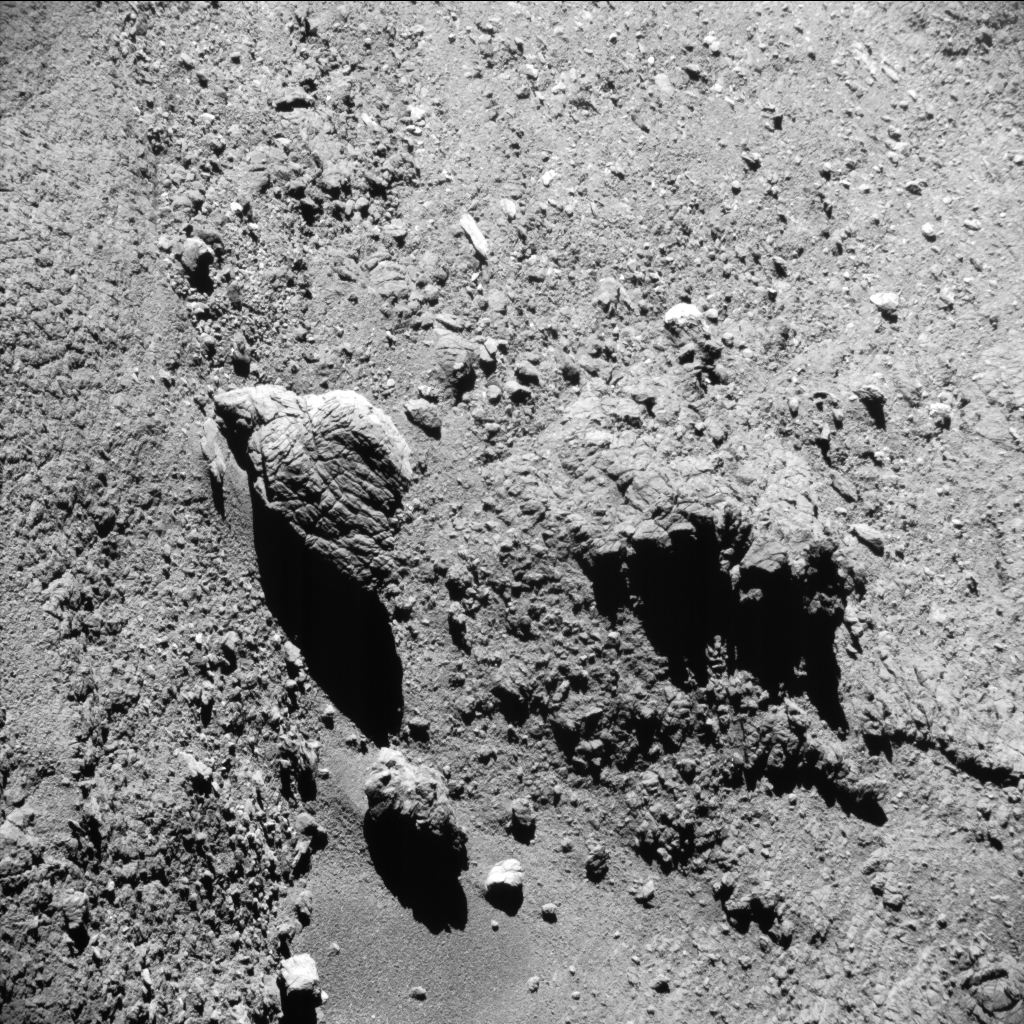
Enhanced NAVCAM image of Comet 67P/C-G taken on 14 September 2016, 4.2 km from the comet centre and about 2.6 km from the surface. The distance from Rosetta to the closest pixel in this image is 2.4 km. The scale is 0.2 m/pixel and the image measures about 225 m across. Credits: ESA/Rosetta/NAVCAM – CC BY-SA IGO 3.0
This image provides a detailed view of small and large boulders scattered in the Anubis region, which is also located on the large comet lobe and separated by a scarp from Seth. A context view is provided in the image on the right.
On the right in the composite (and shown below), an image from 11 September shows another view of the Seth region.
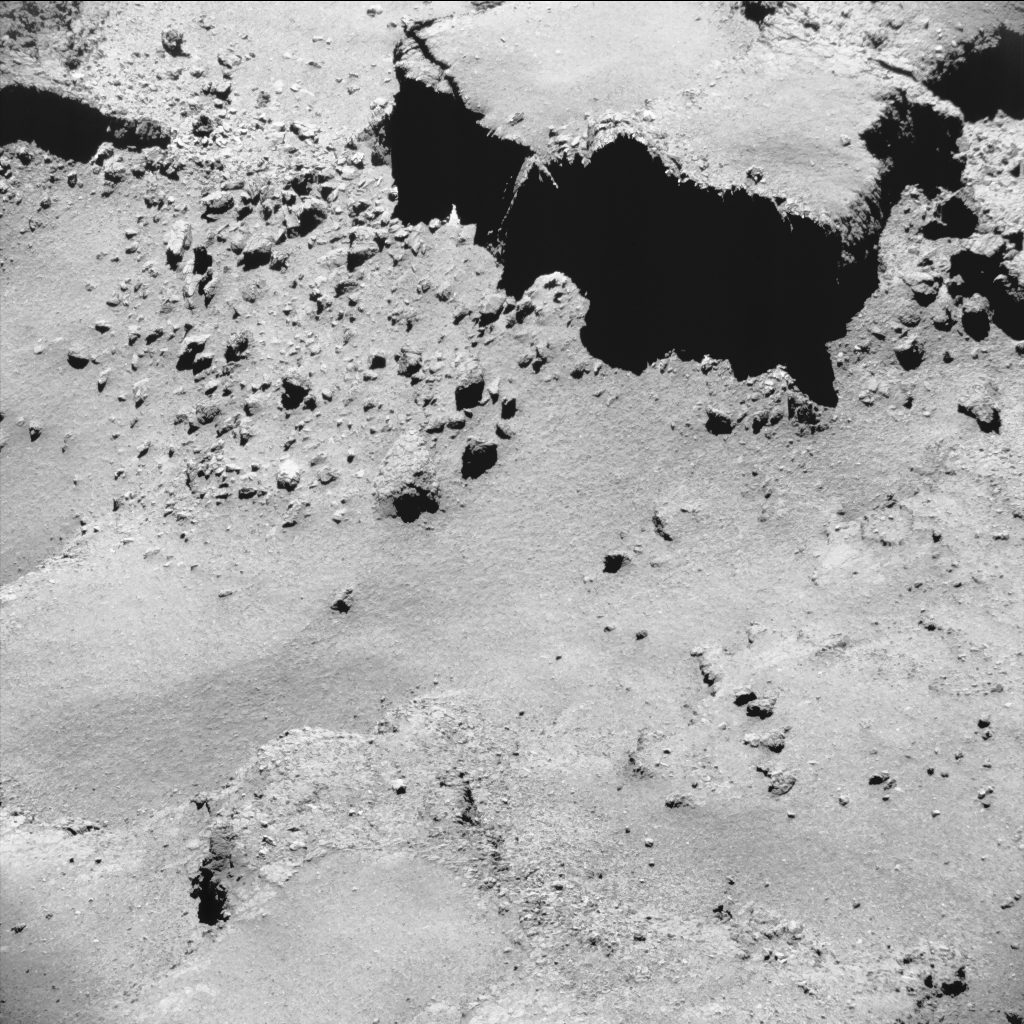
Enhanced NAVCAM image of Comet 67P/C-G taken on 8 September 2016, 4.5 km from the comet centre and about 3.5 km from the surface. The distance from Rosetta to the closest pixel in this image is 3.2 km. The scale is 0.3 m/pixel and the image measures about 310 m across. Credits: ESA/Rosetta/NAVCAM – CC BY-SA IGO 3.0
Taken about 3.5 km from the comet surface, the view reveals a terrace casting dramatic shadows on the underlying terrain, covered in dust and boulders. A context view is provided in the image on the right.
Comet 67P/Churyumov–Gerasimenko is now moving along the part of its orbit that is farthest from the Sun, in the outer Solar System, between the orbits of Mars and Jupiter. Today, it is over 600 million km from the Sun and over 740 million km from Earth.
All images from Rosetta’s navigation camera are available online via the Archive Image Browser.
The three original NAVCAM images are provided below.

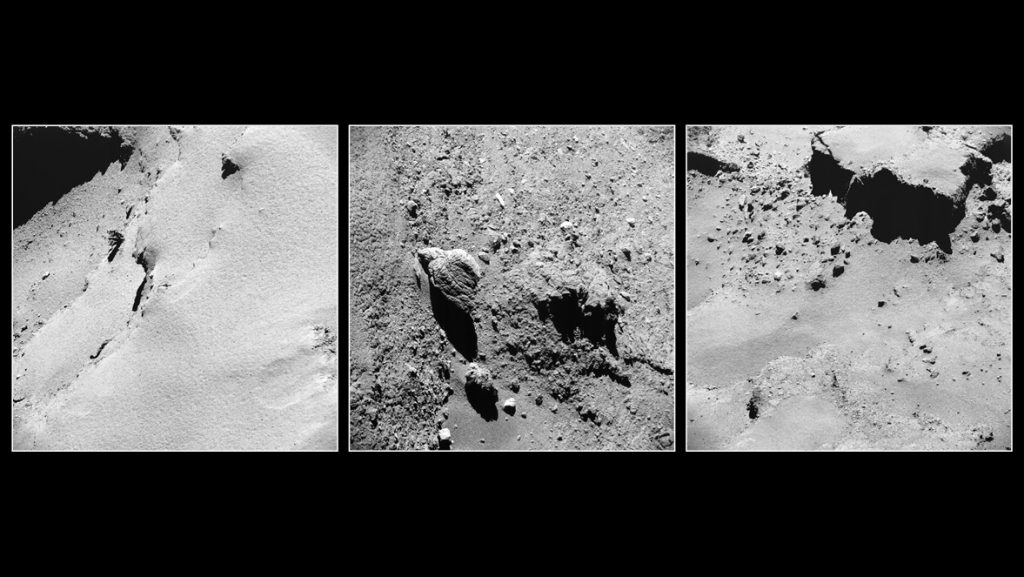
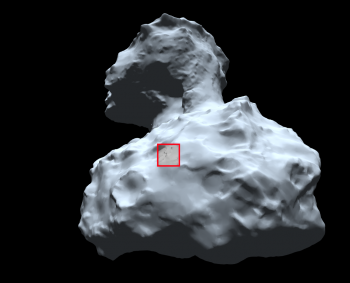
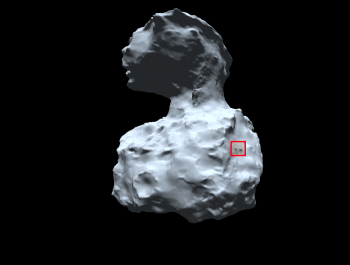
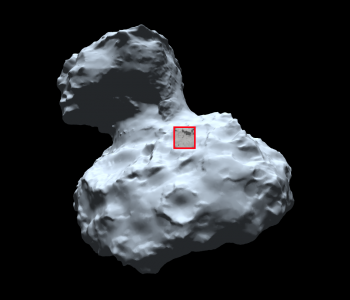











Discussion: 4 comments
Hi Claudia
In the last photo, you refer to a terrace casting a shadow. This is an almost free-standing blocky rectangle with vertical cliffs on three sides and a fairly steep slope along some of the fourth side. The last part slopes away gently and is visible in the extreme top-right corner of the photo.
Although ‘terrace’ is the correct term for a single, flat-topped block, most people think of a geological terrace as being part of several flat-topped steps in a stepped feature. This assumption might lead readers to the conclusion that there’s an ascending slope or cliff to another higher step behind this one. That slope/cliff would be mostly off-screen if it existed.
However, knowing for sure that this is a very well-defined rectangular block, isolated from any associated terracing is crucial to understanding its morphological evolution. If readers and scientists walk away from seeing this photo without knowing the (off-frame) context in which the blocky rectangle sits, they may go for weeks before they notice it, by chance, from the other direction and realise it isn’t part of a terrace and is in fact a very interesting, isolated feature. Its isolation must surely say something about its morphological evolution.
If it’s not part of a terraced feature, it’s somewhat harder to explain its vertical cliffs on three sides and slope on the fourth side and do so in the context of extensive, differentially eroding layers. It’s a small rectangle, not an extensive layer and looks much more like a mesa which may suggest a different structural or constituent makeup (as is the case with terrestrial mesas). Conversely, the extensive terracing across Aswan does suggest extensive, closely-packed mini-layers.
An alternative to the possible difference in structural or constituent makeup with respect to its surroundings, is the possibility that it was isolated via rifting alone. This would mean that it was part of an extensive layer, after all, and that the rest of the layer got yanked away on all sides.
I’m trying not to go down the path of fathoming how the evolution of this block actually played out. I’m talking about the basic approach of needing to have full knowledge of what’s off-frame in order to have any chance of understanding a feature that’s on the edge of the frame. To do that, one needs to look at multiple photos from different angles and lighting. But if you’re not familiar with what’s off-frame in the first place, you might not realise the interesting nature of the feature and therefore won’t even embark on a thorough analysis.
That’s why I’m writing this comment. I’ve gone through the process of missing the significance of a 67P feature due to a lack of off-frame context and done so for perhaps a hundred such features. This blocky rectangle is one of them. So I’m able to save readers and scientists the time and trouble of discovering these interesting features. I can flag them up as being worth the extra study from all angles because I’ve already done it the slow, ad-hoc way. This rectangle is one of the most bizarre features on the comet especially when viewed along with the gentle blanket-like slope that extends further off-frame, top-right, for 300 metres. Also, when it’s viewed alongside that boulder field that stops in an abrupt line halfway along the cliff. The boulder field is off-frame in other photos that do show the blanket. The blanket and the highly delineated boulder field are surely indirect clues as to why the blocky rectangle is the shape it is.
Off-frame context is everything.
Thank you for this in depth description. The block feature described is both bizarre and fascinating. Please point us in any direction in which you have analyzed this or other features contextually both in and off frame on 67P. Cheers, Andrew
Hi Andrew
You’ve prompted me to do a blog post on the history of the blocky rectangle. It illustrates my above comment because things happening as far away from it as Apis and Nut had a direct effect on its morphological evolution (in my view according to stretch- not a mainstream view). The link also has all the usual caveats about stretch as I always state for tailored links to specific reply-comments from here. That’s so as not to waste the time of those interested only in peer-reviewed literature. Here’s the post:
https://scute1133site.wordpress.com/the-blocky-rectangle/
In my other comment above, I was studiously avoiding getting into describing the blocky rectangle’s history because I was using it as an example for a more general principle of looking off-frame i.e. in other photos showing nearby terrain and features. Now that’s done, I’m very happy to point you to specific areas where a feature’s morphological evolution depended on what was going on a very long way away i.e. off-frame for any moderate close-up, and certainly off-frame in the case of OSIRIS paper close-ups that are very close.
Parts 40, 44/5, 52, 57 and 62 show a similar narrative for how the shaping forces of a certain feature or features occurred hundreds of metres away from where they now sit (according to stretch). Also Parts 51/61 regarding one striking geometrical feature at Aker that delaminated orthogonally, sharing matching pieces of itself all across that end of the comet (mauve feature in that post). These examples all involve long distances across one or other separate lobe as well as the obviously long distance involved in matches between the two lobes when invoking stretch.
Don’t worry, your comment also prompted me to do a long-overdue page of links to all the parts for easy navigation (mostly for me finding the relevant parts to link!).
Andrew Cooper
Pics look amazing! Thanks for article. I hope that soon will live on Mars!